Morphology of Flowering Plants
Maharashtra Board-Class-11-Science-Biology-Chapter-9
Notes-Part-2
Topics to be Learn : Part-2
|
Leaf :
- Leaves are the most important appendages as they carry out photosynthesis and also help to remove excess amount of water from plant body through transpiration. '
- Leaves are exogenous in origin and develops from leaf primordium.
- Leaf is dorsiventrally flattened lateral appendage of stem, produced at nodal region.
- Leaf is thin, expanded and green due to presence of photosynthetic pigments, i.e. chlorophyll.
- Axil of leaf shows presence of axillary bud.
- Leaf shows limited growth, does not show apical bud or a growing point.
Typical leaf structure :
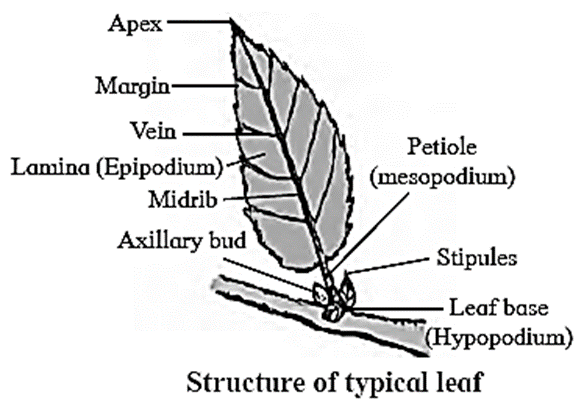
It shows presence of three main parts
- Leaf base or Hypopodium,
- Petiole or Mesopodium
- Leaf lamina/blade or epipodium.
Leaf base or Hypopodium:
- The point by which leaf remains attached to the stem is known as leaf base.
- The nature of leaf base varies in different plants. It may be pulvinus (swollen), sheathing or ligulate etc.
- In some plants leaves possess a pair of lateral outgrowths called as stipules.
- d. The leaf with stipule is said to be stipulate and without stipule is ex-stipulate.
- Stipules are normally green protective structure.
Petiole or Mesopodium:
- The part of leaf which connects leaf lamina with the leaf base is known as petiole of a leaf.
- A leaf with petiole is termed as petiolate and a leaf without petiole is termed as sessile leaf
- Petiole helps lamina to get exposed to light and also helps in conduction.
Lamina or Epipodium :
- It is the large expanded, flat and green part of a leaf.
- The lamina surface plays an important role in photosynthesis, and transpiration
- The leaf is either doislventral or isobilateral.
- Dorsiventral leaf is common in dicots and isobilateral in monocots.
- In centric or cylindrical leaves both the surfaces of leaf cannot be distinguished distinctly.
- Leaf lamina varies greatly in shape, margin and apex.
Leaf venation: ‘
Arrangement of veins and veinlets in leaf lamina is known as venation.
- Veins are responsible for conduction of water and minerals as well as food.
- The structural framework of the lamina is developed by veins.
- There are two types of leaf venation: parallel venation which is found in monocot leaves and reticulate venation which is found in dicot leaves.
Types of leaf venation :
Reticulate venation :
- In reticulate venation, veins and veinlets form a network.
- It is found in dicotyledonous plants

On the basis of number of mid-veins, reticulate venation is of two types:
Pinnate or unicostate: It is with single midrib e.g. Peepal, Mango.
Palmate or multicostate: It is with two or more prominent veins. It is further divided into convergent or divergent.
- Multicostate convergent reticulate: Many prominent veins appear from the base of leaf lamina and converged in a curved manner towards the leaf apex. e.g. Zizyphus
- Multicostate divergent reticulate: Prominent veins arise from the single point at the base of leaf lamina and then diverge from one another towards the leaf margin. e. g. Cucurbita
Parallel venation :
In parallel venation, veins run almost parallel to one another.
It is found in monocotyledonous plants

It is of two types:
Unicostate: In this, lamina has single prominent mid vein from which many lateral parallel veins arise at regular intervals. e.g. Banana
Multicostate : In this, two or more mid veins run parallel to each other. It is further divided into convergent or divergent. '
- Multicostate convergent parallel: Many prominent veins arise from the leaf base and then converge at leaf apex. e.g. Grasses
- Multicostate divergent parallel: Many prominent veins arise from the leaf base and then diverge towards margin. e.g. Borassus flabellifer(Toddy palm)
Types of leaf :
Based on incision of lamina leaves are of two main types. i.e. simple and compound.
The leaf with entire lamina is called simple leaf, whereas leaf in which leaf lamina is divided into many leaflets is called as compound leaf.
Types of Compound leaf :
(i) Pinnately compound : Leaflets are present laterally on a common axis called rachis, which represents the midrib of the leaf.

(ii) Palmately compound : In which all the leaflets are attached at tip of petiole.

Modification of leaves :
Other than photosynthesis leaf also performs transpiration gaseous exchange and perception of light for flowering.
Leaves may undergo modifications to perform such several other functions.
Leaves show different types of modification as follows:
(i) Leaf spines:
Sometimes entire leaf is modified into spines or margin of leaf becomes spiny (Agave) or stipule modifies into spine (Acacia, Zizyphus) to check the rate of transpiration and to protect plant from grazing.
(ii) Leaf tendril :
In some weak stems, leaf, leaflet or other part modifies to produce thin, green, wiry, coiled structure called as leaf tendrils. It helps in climbing and provides additional support.
(iii) Leaf hooks:
In plants like Bignonia unguis-cati (Cat’s nail) the terminal three leaflet get modified into three stiff curve and pointed hooks used to cling over the bark of tree.
(iv) Phyllode:
When petiole of leaf becomes flat, green and leaf like it is called as phyllode. In Acacia auriculoformis the normal leaf is bipinnately compound and falls off soon. The petiole modifies itself into phyllode. It is a xerophytic adaptation.
Phyllotaxy :
Arrangement of leaves on the stem and branches in a specific manner is known as phyllotaxy. It enables leaf to get sufficient light for photosynthesis.
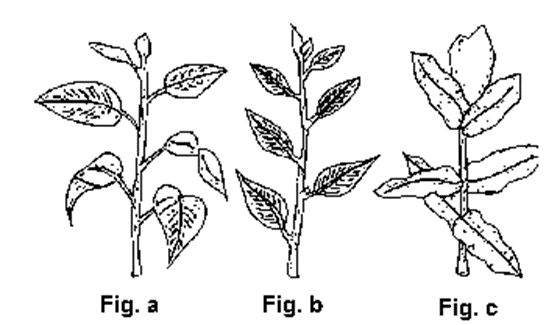
- Alternate phyllotaxy: In this type of phyllotaxy, single leaf arises from each node of a stem (Fig. a and b). e.g. Mango.
- Opposite decussate phyllotaxy : In this type of phyllotaxy, a pair of leaf arise from each node and the consecutive pair at right angle to the previous one.(Fig. c) e.g. Calotropis, Jamun.
Inflorescence :
A specialized axis or branch over which flowers are produced or borne in definite manner is known inflorescence. Inflorescence has two parts Peduncle and flowers.
Significance of inflorescence:
- Inflorescence makes a flower more conspicuous to attract the insects and birds for pollination.
- It provides more chances for cross pollination.
- An insect can pollinate many flowers in inflorescence in a single visit.
- In an inflorescence, flowers open successively and not simultaneously. This improves chances of pollination as flowering period is longer.
Types of inflorescence :
Racemose :
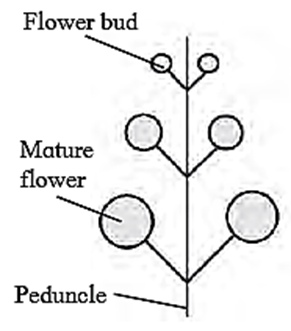
- Growth of peduncle is infinite or unlimited.
- Apical bud never terminates into flower,
- Flowers are arranged in acropetal succession (i.e, younger flower at the apex and older at the base).
- Opening of flowers is centripetal (younger flowers towards the centre and open later while older towards Periphery and open first).
- E.g. Gold mohur, Sunflower.
Cymose :
- Growth of peduncle is finite or limited.
- Apical bud always terminates into flower.
- Flowers are arranged in basipetal succession (i.e. older flowers at the apex and younger at the base).

- Opening of flower is centrifugal (older flowers at the centre and open first while younger towards periphery and open later)
- E.g. China rose, Jasmine
Flower :
Flower is highly modified and condensed shoot meant for sexual reproduction.
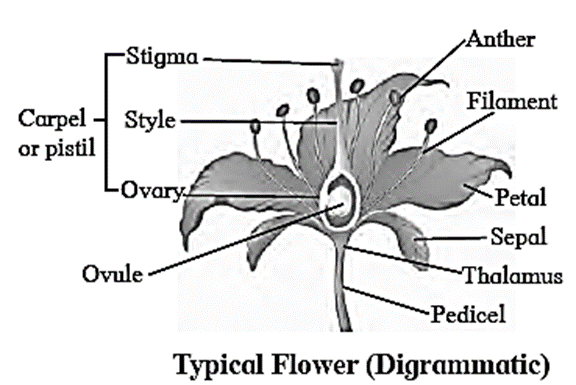
Terminologies related to flower :
- Complete flower: Presence of all four floral whorls
- Incomplete flower: Absence of any one of the floral whorls,
- Pedicellate flower: Flower with pedicel.
- Sessile flower: Flower without pedicel.
- Bracteate flower: Flower with bract at the base of pedicel
- Ebracteate flower: Flower without bract.
- Perfect flower: Both androecium and gynoecium are present, also called as hermaphrodite or bisexual
- Imperfect flower: Any one reproductive whorl is present also called as unisexual flower.
- Actinomorphic flower: The flower can be cut in any plane passing through the centre in order to obtain two identical halves. Flowers show radial Symmetry. e.g. Sunflower.
- Zygomorphic flower: The flower can be cut only along one plane passing through the centre in order to obtain two identical halves. Flowers show bilateral symmetry e.g. Sweet Pea flower.
- Unisexual flower: It can be either staminate (male)/Pistillate (female) flower.
- Neuter flower: When both reproductive whorls are absent, it is said to be neuter flower.
- Monoecious plant: Male and female reproductive flowers are borne on same plant. e.g. Maize
- Dioecious plant: Only one type of unisexual flowers are present on plant. e.g. Ray floret of sunflower.
- Polygamous plant : Mango produces all types of flowers like staminate, bisexual and neuter, hence it is called as polygamous plant.
Insertion of floral whorls :
The position and arrangement of rest of the floral whorls (calyx, corolla, androecium) with respect to gynoecium on the thalamus is known as insertion of floral whorls.
Thalamus:
- The upper, swollen, condensed, knob-like part of the pedicel is called thalamus. It is also called receptacle or torus.
- In a typical flower, the thalamus consists of four compactly arranged nodes and three highly condensed internodes.
- From each node of thalamus, whorl of modified leaves is produced.
- Slope of thalamus decides insertion of floral whorls.
- Thalamus is green in colour hence it can perform the process of photosynthesis.
Classification of flowers based on the position of ovary on the thalamus :
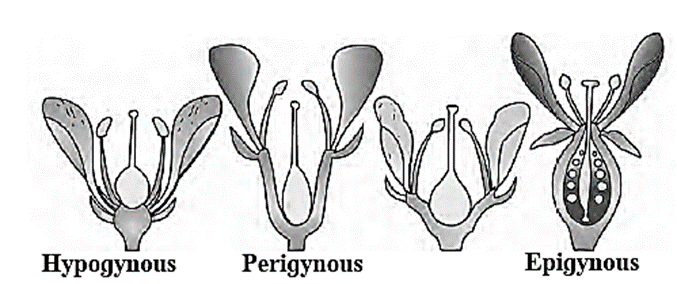
Hypogynous flower:
- When the convex or conical thalamus is present in flower, ovary occupies the highest position while other floral parts are below ovary. Ovary is said to be superior and flower is called as hypogynous flower.
- E.g. Brinjal, Mustard, China rose ete. .
- It is denoted as G in floral formula.
Perigynous flower:
- When cup shaped or saucer shaped thalamus is present in a flower, ovary and other floral parts occupy about same position. Such an ovary is said to be semi- superior or semi-inferior. All floral whorls are at the rim of thalamus. Flower is called as perigynous.
- E.g. Rose, etc.
- It is denoted as G- in floral formula.
Epigynous flower:
- When thalamus completely encloses ovary and may show fusion with wall; the other floral parts occupy superior position and ovary becomes inferior. Such flower is called as epigynous flower.
- E.g. Ray florets of Sunflower, Guava, Cucumber etc.
- It is denoted as in floral formula.
Floral parts and their structure : All floral parts develop from thalamus from different nodes.
Calyx (K):
- It is outermost floral whorl and individual members are known as sepals.
- Sepals are usually green in colour and perform photosynthesis.
- If all the sepals are united, the condition is gamosepalous and if they are free, the condition is called as polysepalous.
- Gamosepalous calyx is found in China rose and polysepalous calyx is found in Brassica.
- The main function of sepals is to protect inner floral parts in bud condition.
- Sometimes sepals become brightly coloured (petaloid sepals) and attract insects for pollination e.g Canna, Mussaenda etc.
- Sepals modify into hairy structures called as pappus. Such calyx helps in dispersal of seeds or fruits. e.g. Sonchus.
Know This :

Corolla (C):
- It is second floral whorl from outer side and variously coloured.
- The individual member is called as petal.
- Petals may be sweet to taste, possess scent, odour, aroma or fragrance etc.
- The condition in which petals are free is said to be polypetalous (e.g. Rose) and if they are fused it is called as gamopetalous (e.g. Datura).
- The main function of corolla is to attract different agencies for pollination.
Perianth (P):
- Many times, calyx and corolla remain undifferentiated. Such member is known as tepal.
- The whorl of tepals is known as Perianth.
- It protects other floral whorls.
- If all the tepals are free the condition is called as polyphyllous and if they are fused the condition is called as gamophyllous.
- Sepaloid perianth shows green tepals, while petaloid perianth shows brightly coloured tepals. e.g. Lily, Amaranthus, Celasia, etc.
- Petaloid tepal helps in pollination and sepaloid tepals can perform photosynthesis.
Androecium (A):
- It is third floral whorl from outer side.
- Androecium is male reproductive part of a flower.
- The individual member is known as stamen.
- If all the stamens are free the condition is polyandrous and synandrous if they are fused.
Typical stamen shows three different parts:
- Anther: It is terminal in position. Anther produces pollen grains. It is usually dithecous (two anther lobes), tetralocular/tetra sporangiate (four pollen sacs) structure. e. g. Datura. In some plants it is monotheocus (single lobed), bilocular or bisporangiate structure e. g. Hibiscus.
- Filament: It is a stalk of stamen and bears anther at its tip. It raises anther to a proper height for easy dispersal of pollen grains.
- Connective: It is in continuation with the filament. It is similar to mid rib and connects two anther lobes together and also with the filament.
Gynoecium (G):
- It is the female reproductive part of a flower and innermost in position.
- It is also known as pistil.
- The individual member of gynoecium is known as carpel.
- The number of carpels may be one to many.
- If all the carpels are fused the condition is described as syncarpous and if they are free the condition is described as apocarpous.
- The polycarpellary gynoecium can be bicarpellary (two carpels e.g. Datura), tricarpellary (three carpels e.g. Cucurbira), pentacarpellery (five carpels e.g. Hibiscus) and so on.
- A typical carpel consists of three parts stigma, style and ovary. .
- Stigma is a terminal part of carpel which receives pollen grains during pollination. It helps in germination of pollen grain. Stigma shows variation in structure to suit the pollinating agent.
- Style is narrow thread like structure that connects ovary with stigma.
- Ovary is basal swollen fertile part of the carpel. Ovules are produced in ovary on a soft fertile tissue called placenta.
| Remember :
Epicalyx:
|
Aestivation:
The mode of arrangement of sepals, petals or tepals in a flower with respect to the members of same whorl is known as aestivation.
Different types of aestivation are as follows:
- Valvate: Margins of sepals or petals remain either in contact or lie close to each other but do not overlap. e.g. Calyx of Datura, Calotropis.
- Twisted: Margins of each sepal or petal is directed inwards and is overlapped. While the other margin is directed outwards and overlap the margin of adjacent. e.g. Corolla of China rose, Cotton etc.
- Imbricate: One of the sepals or petals is internal and is overlapped at both the margins. One is external i.e. both of its margin overlap adjacent member. Rest of the sepals / petals have one inner or overlapped margin and outer or overlapping margin. e.g. Cassia, Bauhinia, etc.
- Vexillary: Corolla is butterfly shaped and consists of five petals. Outermost and largest is known as standard or vexillum, two lateral petals are wings and two smaller fused forming boat shaped structures keel. e.g. Pisum sativum.

Types of stamens :
Adelphy: When stamens are united by filaments and anthers are free, the condition is called adelphy
Three types of stamens based on adelphy:
Monoadelphous stamens, Diadelphous stamens, Polyadelphous stamens.
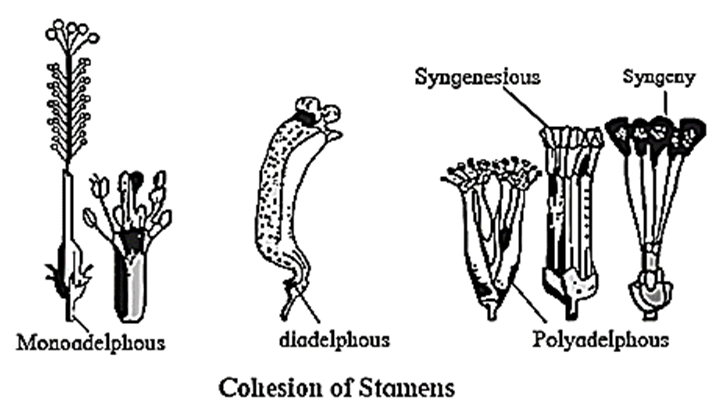
- Monoadelphous: In Hibiscus, there are numerous stamens. Filaments of all stamens are fused to form one bundle, i.e. staminal tube and anthers are flee. This is described as monoadelphous condition.
- Diadelphous: In pea flower, there are ten stamens. Filaments of nine stamens are fused to form one bundle and one stamen is free. This is described as diadelphous condition.
- Polyadelphous: In some flowers like lemon, more than two bundles of filaments are formed and it is described as polyadelphous condition.
Epipetalous stamens:
When the stamens are united to petals or tepals they are described as epipetalous stamen. E.g. Datura (Note: When the stamens are united to tepals they are described as epiphyllous. E. g. Lily)
Syngenesious stamens:
When anthers are united and filaments are free, such stamens are called as syngenesious stamens e.g. Sunflower
Synandrous stamens:
When both anthers and filaments are fused, such stamens are called as synandrous stamens. e.g. Cucurbita
Placentation :
The mode of arrangement of ovules on the placenta within the ovary is placentation.
Types of placentation :

- Marginal: Ovules are placed on the fused margins of unilocular ovary. e. g. Pea, Bean etc.
- Axile: Ovules are placed on the central axis of a multilocular ovary. e.g. China rose, Cotton, etc.
- Parietal: Ovules are placed on the inner wall of unilocular ovary of multicarpellary syncarpus ovary. e. g. Papaya, Cucumber, etc.
- Basal: Single ovule is present at the base of unilocular inferior ovary. e.g. Sunflower, Rice, Wheat.
- Free central: Ovules are borne on central axis which is not attached to ovary wall. e.g. primrose.
Fruit :
Angiosperms produce fruit after fertilization, from ovary.
- Fruits which are produced from ovary without fertilization are called as paithenocarpic fruits. e.g. Banana (natural parthenocarpic fruit), Grapes (Varieties developed by application of growth hormone).
- The fruit which develops only from ovary is called as true fruit or eucarp. e.g. Mango.
- The fruit which develops from ovary along with other floral part is called as false fruit or pseudofmit. e.g. Apple.
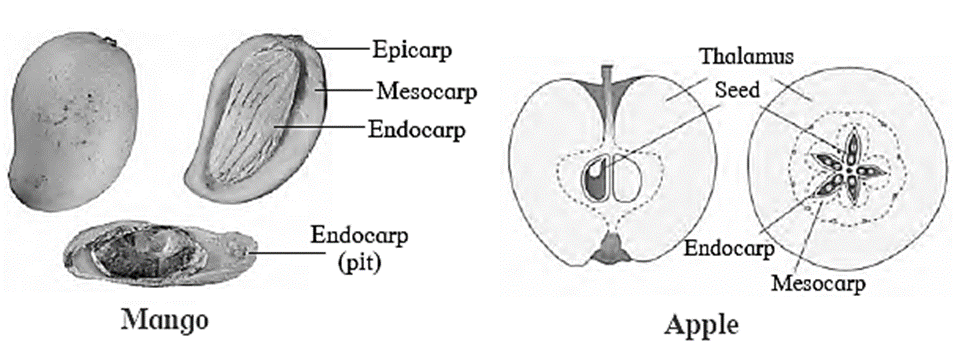
Simple fruits : Fruits which develop from one ovary of one flower are called as simple fruits.
Types of simple fruits on the basis of their pericarp:
Dry fruits: These fruits have thin peiicarp. It is further divided into two types:
- Dehiscent dry fruits: Pericarp becomes dry, thin and fruit opens at maturity. e.g. Capsule (Lady's finger) and legume (Pea)
- Indehiscent dry fruits: Fruit does not open. e. g. Achene (Mirabilis), Caryopsis (Maize) and Cypsela (Sunflower)
Fleshy fruits: These fruits have thick pericarp. It is further divided into two types based on nature endocarp:
- Drupe: In these fruits, endocarp is hard and stony. e.g. Mango
- Berry: In these fruits, endocarp is fleshy and fruit is many seeded. e.g. Tomato
Aggregate fruits : The fruit which develops from a single flower with many ovaries of polycarpellary, apocarpous gynoecium is known as aggregate fruit or etaerio.
Types of aggregate fruits:
- Etario of achenes (e.g. Strawberry), etario of berries (e.g. Custard apple), etario of follicles (e. g. Calotropis)
Composite fruits:
- The fruits which develop from many ovaries of many flowers of a complete inflorescence are called composite fruits. (e. g. fig)
- Fruits which develop from catkin inflorescence are called sorosis (e. g. Pineapple).
- Fruits which develops from hypanthodium inflorescence are called syconus.
| Know This :
Tomato :
Custard apple :
Pineapple :
Milkweed :
|
Seed :
Seed is a reproductive unit that is developed from a fertilized, mature ovule.
Structure of a seed:
- The seed is made up of seed coat and one or two cotyledons.
- Outer most covering of a seed is called seed coat.
- It shows outer layer called as testa and inner layer called as tegmen.
- Hilum is a scar on the seed coat through which seed attach to the fruit.
- Embryo of a seed is enclosed within seed coat.
- Embryonal axis consists of radicle and plumule.
- The part of embryonal axis between cotyledon and plumule is epicotyl, while the part between cotyledons and radicle is hypocotyl.
- The nutritive tissue in a seed called endosperm.
- Dicotyledonous seed is a non-endospermic or exalbuminous, as it lacks endosperm at maturity.
Study of some important families :
Families are group of plants having very distinguished common characters.
(i) Fabaceae :
- Example : Pea plant (Pisum sativum)
- Habit : Tree, shrubs, herbs.
- Root : Root with root nodules.
- Stem - : Erect or climber.
- Leaves : Alternate phyllotaxy, Pinnately compound leaves
- Inflorescence : Racemose
- Flower : Zygomorphic, hermaphrodite (Bisexual), complete. -
- Calyx : Sepals five, gamosepalous, imbricate aestivation.
- Corolla : Petals five, polypetalous, consisting of a larger posterior petal vexillum, two lateral petals wings and two anterior ones forming a keel, vexillary aestivation.
- Androecium : Stamens ten, diadelphous.
- Gynoecium : Ovary superior, monocarpellary, unilocular with many ovules, marginal placentation.
- Fruit : Legume.
- Seed : Non-endospermic
- Floral formula : % ⚥K(5) C1+2+(2) A(9)+1 G1
(ii) Solanaceae :
- Example : Thorn apple (Datura stramonium)
- Habit : Mostly herbs, shrubs and rarely small trees.
- Root : Tap root system
- Stem : Herbaceous, woody, erect, branched, hairy, sometimes it may be underground like in potato.
- Leaves : Alternate phyllotaxy, simple, reticulate venation.
- Inflorescence : Solitary, cymose.
- Flower : Actinomorphic, hermaphrodite (Bisexual), complete.
- Calyx : Sepals five, gamosepalous, persistent, valvate aestivation.
- Corolla : Petals five, gamopetalous, valvate aestivation.
- Androecium : Stamens five, free epipetalous (adhesion). ,
- Gynoecium : Bicarpellary, syncarpous, superior ovary, bilocular, placenta swollen with many ovules, axile placentation.
- Fruits : Beny or capsule.
- Seeds : Many, endospennic.
- Floral Formula : ⊕⚥K(5) \(\widehat{C_{(5)}A_{(5)}}\)G(2)
Symbols used in floral formula :
Floral formulae are used to describe a flower using some signs and symbols to designate different parts of a flower.
| ♀ | Female flower | ⊕ | Actinomorphic symmetry |
| ⚥ | Bisexual flower | K | Kalyx |
| ⚦ | Male flower | P | Perianth |
| G- | Semi inferior ovary | G | Gynocium |
| \(\vec{G}\) | Inferior ovary | % | Zygomorphic symmetry |
| G | Superior ovary | Br | Bracteate flower |
| C | Corolla | A | Androcium |
Main Page : – Maharashtra Board Class 11th-Biology – All chapters notes, solutions, videos, test, pdf.
Previous Chapter : Chapter-8- Plant Tissues and Anatomy – Online Notes
Next Chapter : Chapter-10-Animal Tissues – Online Notes
We reply to valid query.